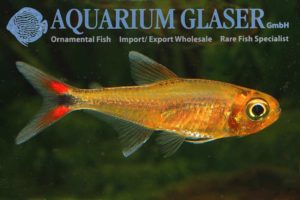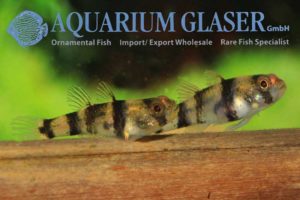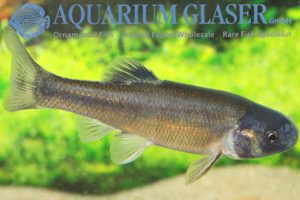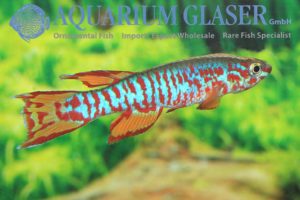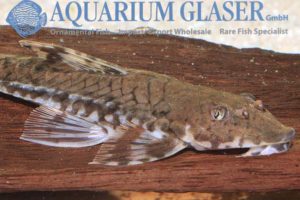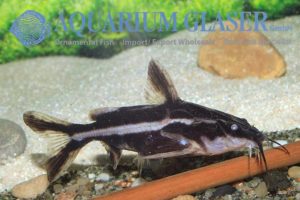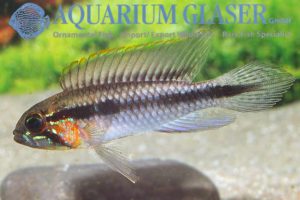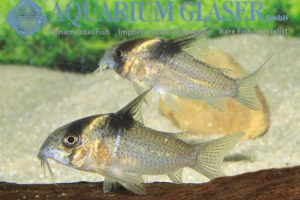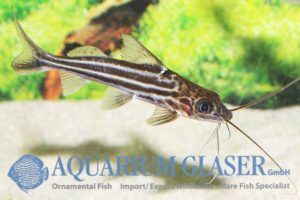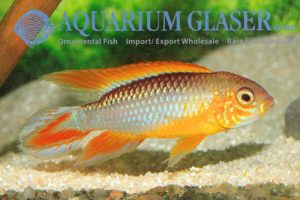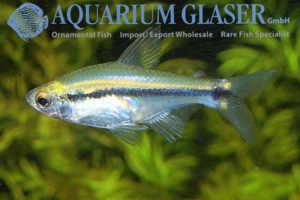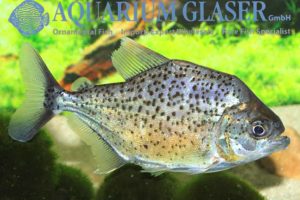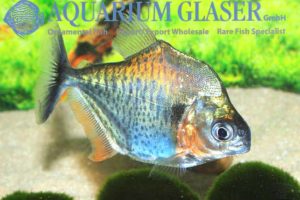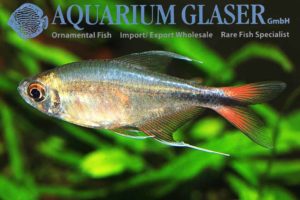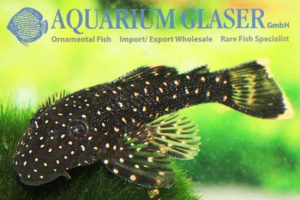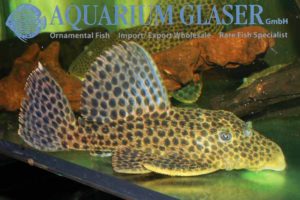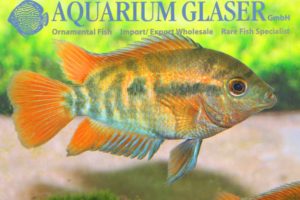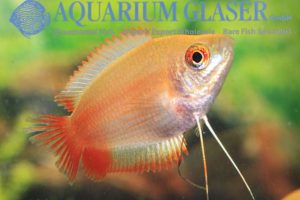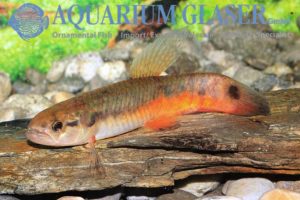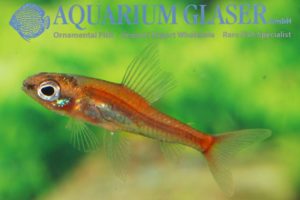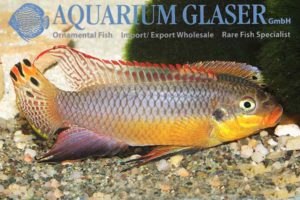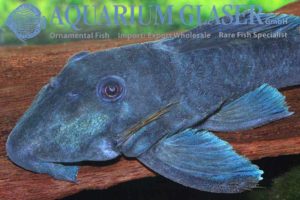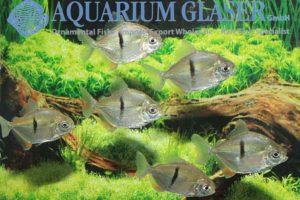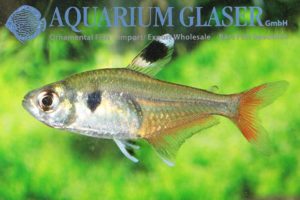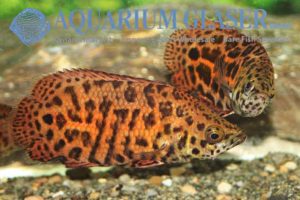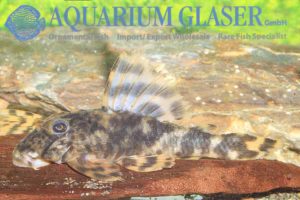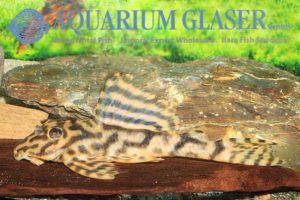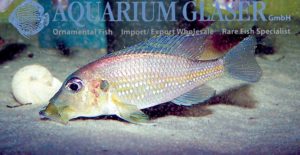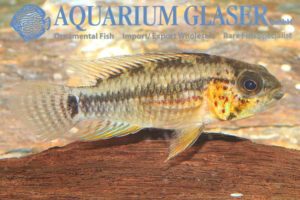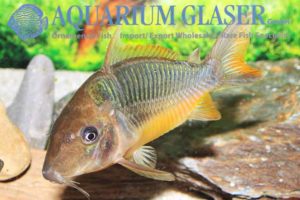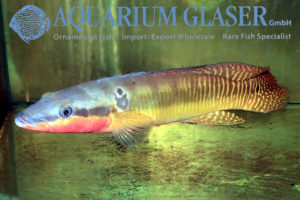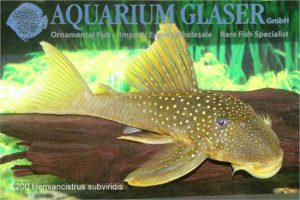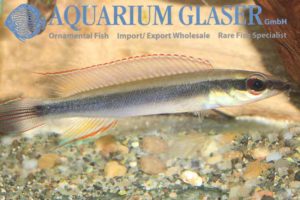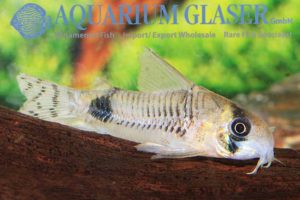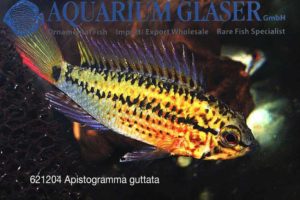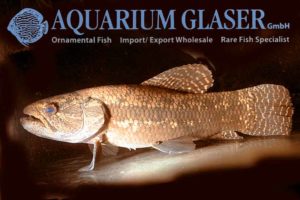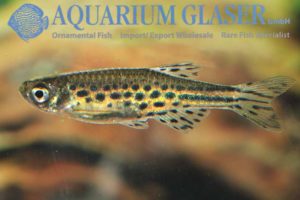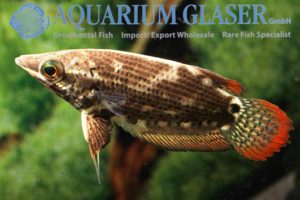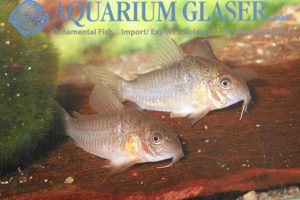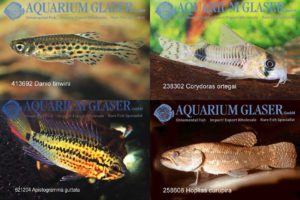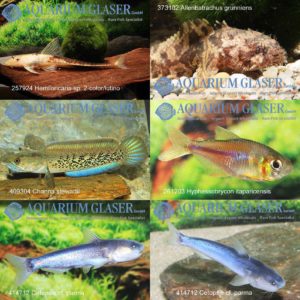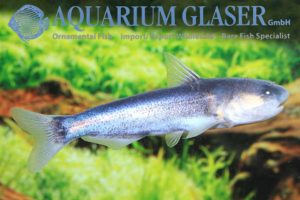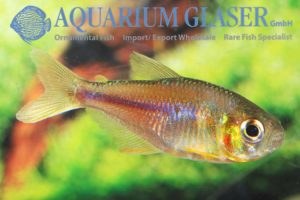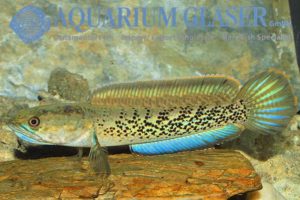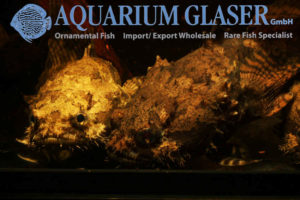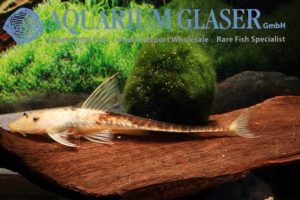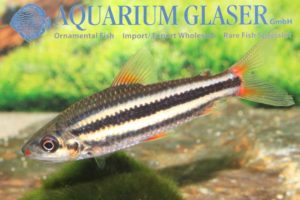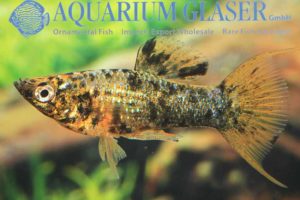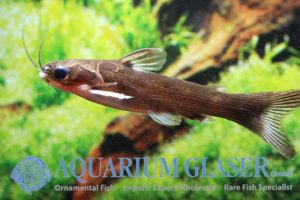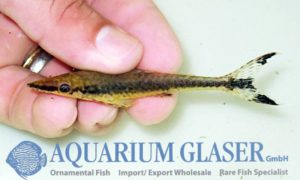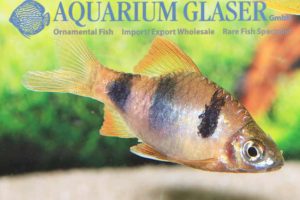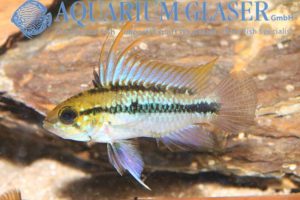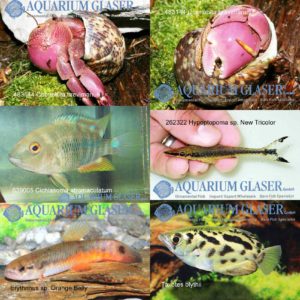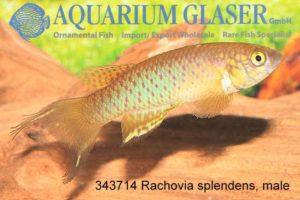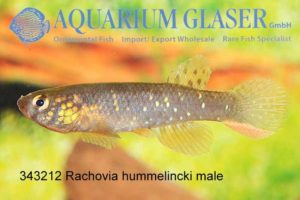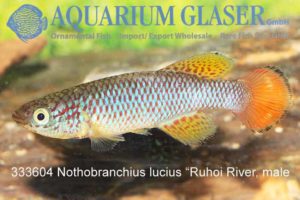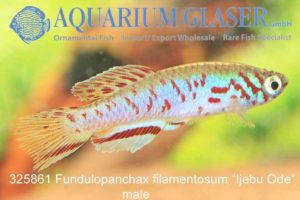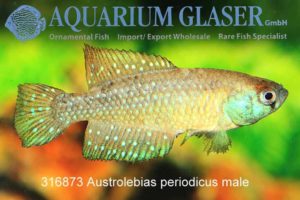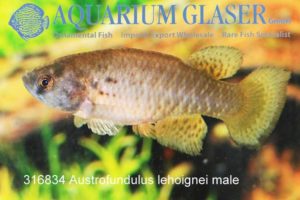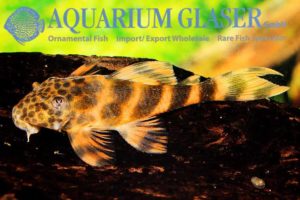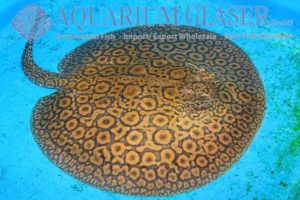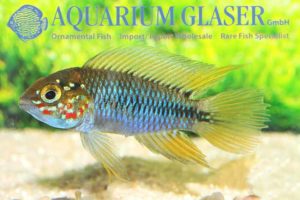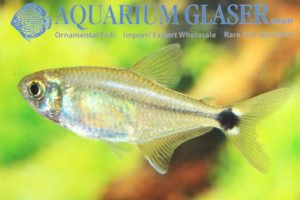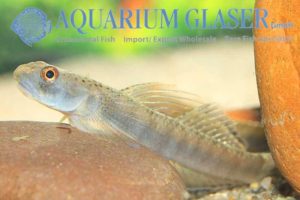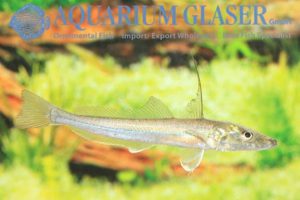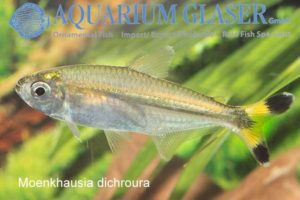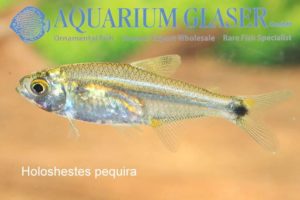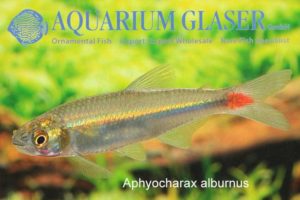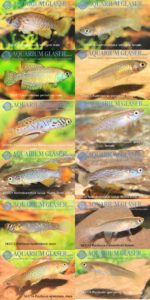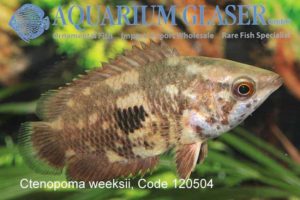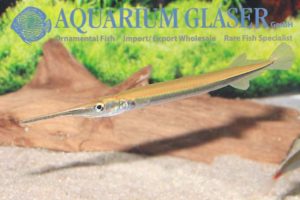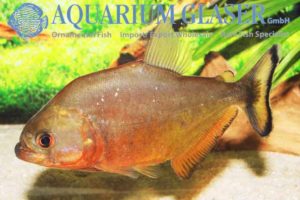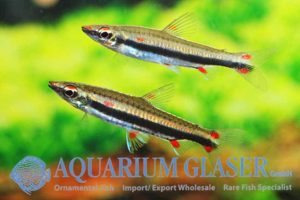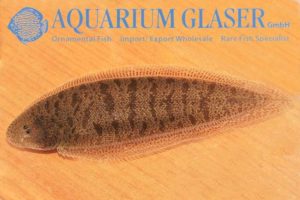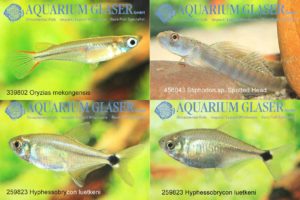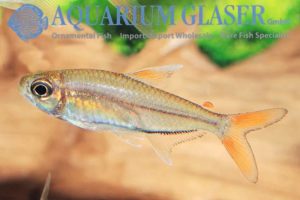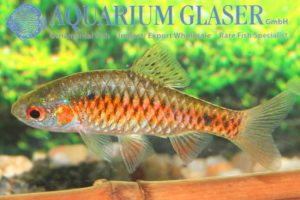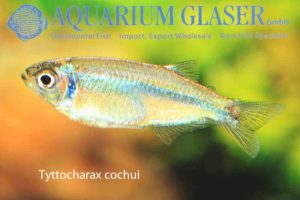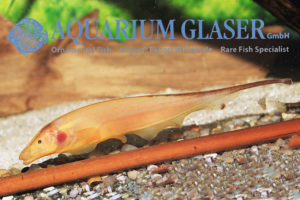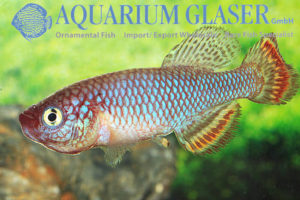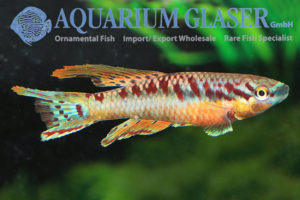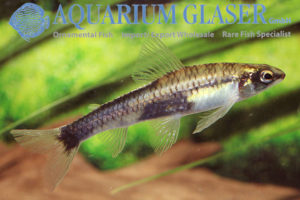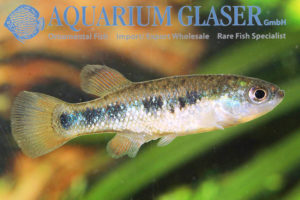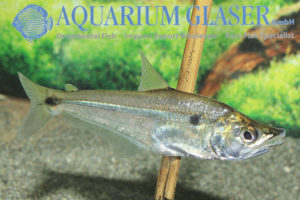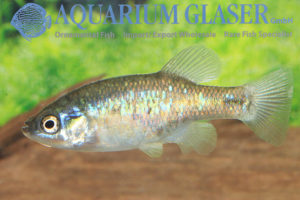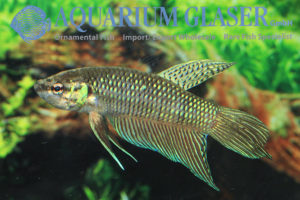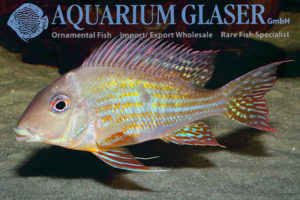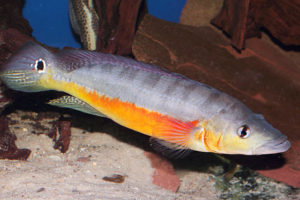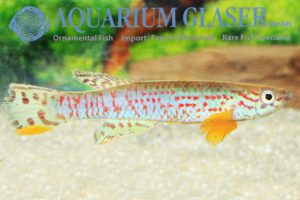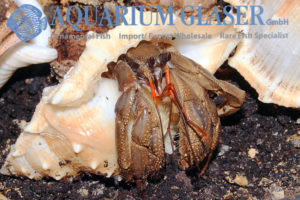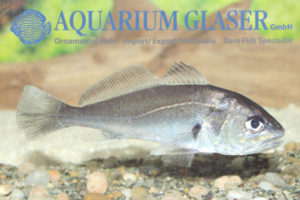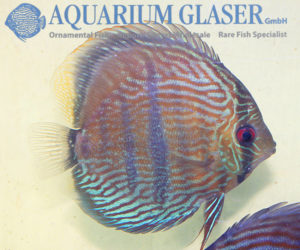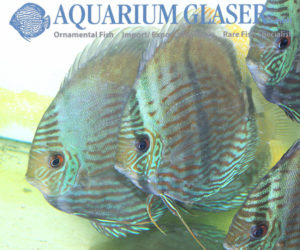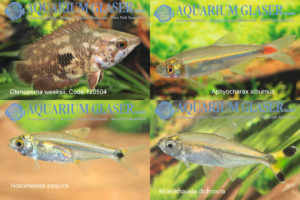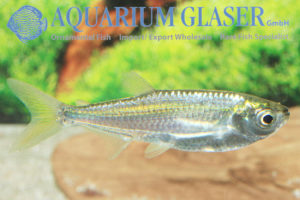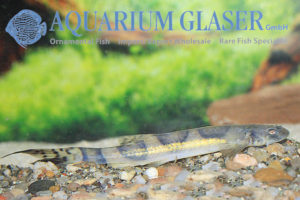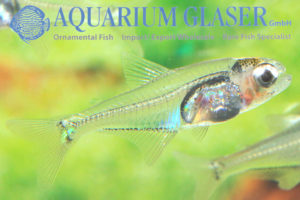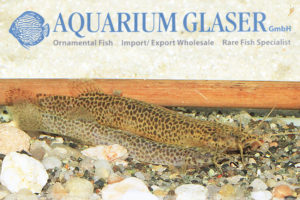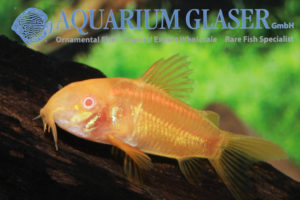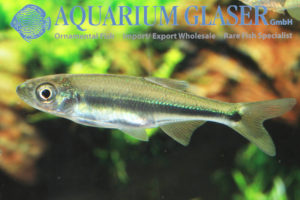After a long time we were able now to import once more this beautiful tetra from Peru. It was not possible so far to place it in a known genus or described species. We chose the name “Hasemania” only because the basic coloration of the fish is somewhat reminescent to that of the well known […]
Fish Archive (2977)
-
-
Brachygobius aggregatus – one of the smallest fishes of the World
All species of bumblebee gobies (Brachygobius) are small or very small fishes. The debate which is the smallest fish of the world (and coincidently the smallest vertebrate of the world) is still going on; however, it is quite difficult to decide, whether it makes sense to debate about differences of tenth of millimeters in live […]
-
Pimephales promelas wild colored & gold
This tiny, hardly 10 cm long species originates from North America. The overall coloration is similar to that of the European minnow (Phoxinus phoxinus) in its eclipse plumage, thus the popular name “Fathead minnow” was chosen for the fish. However, there are important differences regarding life history between the two species. While the European minnow […]
-
Available soon: Aphyosemion dargei Mbam
One of our reliable killifish breeders will be able to supply us with a small number of these Aphyosemion in autumn, which are by far the most complicated ones to breed. Luckily keeping these crown jewels among the ornamental fish is pretty easy as the three males we obtained for photographing purposes in advance show […]
-
Hemiloricaria castroi
It was in August of the past year (2010) that we posted a notice on the successful importation of a wild collected lutiono of Hemiloricaria from Peru (http://www.aquariumglaser.de/en/hemiloricaria-sp-golden-lutino_de_1209.html). The animal is still living in our facility (May 2011) and has changed its coloration completely as can be seen on the new photos. Moreover, now it […]
-
Orinocodoras eigenmanni
The talking catfishes (Doradidae) are an interesting group of fishes in many ways. A lot of the species have a very contrasting pattern of dark and light elements, they can make sounds (that can be compared with a grumbling or gnarling) and their armour of bony plates often looks that bizarr that one might think […]
-
Apistogramma gephyra
This pretty blackwater Apistogramma is imported only very occasionally. Now we were able to manage one of these rare imports again. The fish originates from Brazil where it is found in the central Rio Negro and lower Rio Branco basins. A. gephyra looks quite similar to A. agassizii and its aquarium maintenance is comparable to […]
-
Corydoras cf. bicolor
This beautiful new Cory reached us from Brazil. The black- and-white pattern looks like in C. brevirostris whereas the bright orange-yellow mark on the back (right in front of the dorsal fin) looks like in the very similar species C. bicolor. However, both species do not appear in Brazil as far as it is known. […]
-
Pimelodus tetramerus
The genus Pimelodus is quite specious and currently comprises 34 accepted species. Due to the lack of a recent revision it is not easy to identify the species. In the aquarium hobby only one species is of some importance: P. pictus, the angel catfish. One more species, P. ornatus, is a rare and highly demanded […]
-
Apistogramma agassizii FIRE-RED
Currently we have wonderful, fully grown specimens of this marvelous sport in stock, originating from German breeders. The fish literally seem to glow from inside! It is very interesting that the typical polychromatism that can be observed in wild populations of this dwarf cichlid is also found in this artificial sport. Polychromatism means that coloration […]
-
Serrapinnus sterbai (=7 Rays Mint Tetra)
We imported this new, very nice and interesting tetra for the first time now from Brazil. Obviously this species originates from the Araguaia/Tocantins basin in Central Brazil. In the most current issue of the German aquarium magazine “Amazonas” (Issue 35, May/June 2011, p. 79) this fish is named “7 Rays Mint Tetra” what is adopted […]
-
Pristobrycon striolatus
For the first time ever we succeeded in importing this unique species of piranha from Brazil. Currently the piranhas are placed in 5 genera (Catoprion, Pristobrycon, Pygocentrus, Pygopristis, and Serrasalmus). However, there is some discussion about this classifaction, because intermediate forms have been observed. The species currently placed in Pristobrycon are quite discoid fish as […]
-
Serrasalmus eigenmanni Peru
Serrasalmus eigenmanni Peru This medium sized and very interesting piranha (maximum length reported is around 20 cm) was imported from Peru. This is worth mentioning, as so far S. eigenmanni has been “only” reported from Brazil, the Guyanas, and Venezuela. Our determination bases on the work by Jégu & Santos (1988). Following these authors, the […]
-
Hemigrammus filamentosus (= Hyphessobrycon cf stegemanni Phenix tetra)
Once more we can offer currently this beautiful new dwarf tetra as German bred. At the time we received the fish for the first time it was still undescribed scientifically. The most similar known species was Hyphessobrycon stegemanni. The latter, however, does not have the beautiful long filaments on the fins. In the meantime our […]
-
Ancistrus sp. L180 – wonderful German bred ones available
The Ancistrus species which has the code L180 is only very occasionally imported from Brazil. Obviously there is a number of very similar species existing. In AqualogNews 98 (will appear in May 2011) they will be portrayed in detail. Ancistrus sp. L180 belongs to the yellow-white spotted species of Ancistrus. Currently we have beautiful German […]
-
L234a – a new Megalancistrus
The genus Megalancistrus comprises currently only two accepted species, namely M. barrae from the Rio Sao Francisco and M. parananus, which is distributed in the triangle between Argentina, Brazil, and Paraguay. Two L-numbers have been given to M. parananus: L113 and L234. The species belongs to the largest species of Loricariids at all and can […]
-
Herotilapia multispinosa
This medium sized cichlid – males can become about 12 cm long, females always stay 3-5 cm smaller – originates from Central America (Nicaragua, Costa Rica, Honduras). The fish is a real classic among the species of ornamental fish. It was most popular in the 1970ies. At that time the name “rainbow cichlid” was given […]
-
Colisa chuna “Fire” – A new sport of the honey gourami
Currently we received this extremely cute new sport of the honey gourami from Singapore. The honey gourami is the smallest known species of Colisa and becomes only 3-5 cm long. The new variety has the yellow-golden body of the well known “Gold”-variety of Colisa chuna, but the tail, the caudal fin and the soft parts […]
-
Erythrinus sp. Madre de Dios
Finally we were successful and imported a larger number of this wonderfully coloured predatory tetra from Peru. Both sexes have the splendid orange belly. Females can be recognized by the shape of the ventral fins: they are comparatively small and rounded (large and pointed in males). It is said that the species can attain a […]
-
Odontocharacidium cf aphanes
Once more we were able to import this cute dwarf tetra from Peru. The maximum length of the fish is around 2 cm total length. Despite their small size the males can be very aggressive against each other. If one can keep a lot of them together they are peaceful (the same phenomenon can be […]
-
Pelvicachromis taeniatus Nigeria Yellow
This is another, extreme beautiful variety of that gorgeous dwarf cichlid from Western Africa: Pelvicachromis taeniatus “Nigeria Yellow”. Initially the animal originates from the surroundings of the Nigerian city of Lagos, but we have in stock fully grown adult bred ones. The bright golden breast and the very long finnage make Pelvicachromis taeniatus “Nigeria Yellow” […]
-
L 239, Ancistrinae gen. sp. Blue
We received a shipment of this very nice Pleco from Venezuela. The species becomes only 10-12 cm long. The blue iridescent fins look extremely attractive, but also the remaining parts of the body are blue-blackish coloured. It was not possible so far to place the species in an existing genus and also the species seems […]
-
Myloplus (formerly: Myleus) schomburgkii
Currently we have one of the most beautiful of the large tetras in stock: Myloplus schomburgkii. The magnificent species reaches up to 45 cm in total length, our specimens have the ideal size of 5-7 cm. The photos of the juveniles illustrating this entrance are made from our specimens in stock, while the adults have […]
-
Pseudopristella simulata
Code: 285513
-
Ctenopoma acutirostre wild
It is been a quite long time since we had the last importation of this bushfish from the D. R. Congo. Immediately after their arrival the animals had an unbelievable strong coloration. Sadly it bleached out a bit over the time, but still looks great. Read more about the leopard bushfish here: http://www.aquariumglaser.de/en/archiv.php?news_id=140 For our […]
-
Peckoltia sp. LDA61
We received this nice pleco from Colombia. It is one of the most undemanding plecos at all. The species reaches about 12 cm maximum length. This species has such a variable coloration that a lot of L- and LDA-numbers were given to it. The animals imported now with the additional name “Morruda” (spanish, means “blobber-lipped”) […]
-
Ancistomus sp. L243/LDA86
Recently we received the very nice, only rarely imported species of Ancistomus, which was given the numbers L243 and LDA86, respectively. The species is not described scientifically yet. Like most Ancistomus the species reaches a maximum length of about 15-20 cm and is thus a medium sized species of the family. Ancistomus feed mainly on […]
-
Gnathochromis permaxillaris arrived
This week we received bred specimens of this very rare cichlid from Lake Tanganjika. A breeding report can be found at http://www.aqualog.de/news/web3/3-7.pdf For our customers: the fish has code 520703 on our stocklist. Please note that we exclusively supply the wholesale trade. Lexicon: Gnathochromis: ancient Greek, means “jaw-chromis”, referring to the very special mouth structure. […]
-
Apistogramma sp. Assurini
Currently we received a new Apistogramma from Brazil, a close relative of the species known as A. sp. Xingu in the hobby. Like most Apistogramma, A. sp. Xingu, which has been imported in 1988 for the first time, has developed a number of varieties. Some of them appear within one population, others seem to represent […]
-
Brochis britskii and Brochis cf. splendens CW 35
Two features distinguish the species of Brochis from those of Corydoras: firstly, the enormous size (up to 12 cm) and secondly, the high number of rays in the dorsal fin. While Corydoras have 7-8 rays in the dorsal fin, in Brochis this fin has 10-18 rays. Besides this both genera are distinguished by some externally […]
-
First import! Crenicichla zebrina arrived
This pike cichlid was discovered only in 2002 and described scientifically in 2008. It originates from the lower Ventuari river, the largest tributary of the upper Orinoco in Venezuela. The Ventuari is a clearwater river. Although the Ventuari river is rather good sampled, the describers of that unique species were not able to obtain more […]
-
L 200 and L 200a
Very much sought for is L200 from Venezuela that attains a maximum length of about 20 cm. Actually, there are two mimetic species that hide behind that L-number, which are often confused, although they belong to even different genera. The real L200 is has been described as Hemiancistrus subviridis. It can be easily recognized by […]
-
Crenicichla cf. regani Orinoco
The pike cichlids (Crenicichla) are one of the world´s most specious genera of cichlid. Currently 85 species are accepted. Many of them grow larger than 20 cm but there are also dwarf species. The beautiful, slender Crenicichla regani, which is said in literature to grow to a maximum size of 15 cm (male) or 8 […]
-
Corydoras ortegai
Code: 238302
-
Apistogramma guttata
Code: 621204
-
Hoplias curupira
Code 258608
-
Danio tinwini
Code: 413692
-
Ctenops nobilis
Chocolate gouramis are very beautiful, but demanding anabantoids. Thus they should be kept by experienced aquarists only. There are three genera of chocolate gourami, Sphaerichthys (four species), Parasphaerichthys (two species) and Ctenops (monotypical). The only species in Ctenops is nobilis, the Noble gourami from India. It represents the largest of all chocolate gouramis and can […]
-
Corydoras polystictus PANTANAL
In contrast to the typical variety of C. polystictus, which originates from the upper Rio Paraguay (state of Mato Grosso, Brazil), the Pantanal-variety has much smaller and more numerous spots. Aquarists specialized in Corydoras thus think it is possible that the Pantanal population represents a seperate species. However, even among the Pantanal corys a variation […]
-
New in stock calendar week 7, 2011
Dear customers, our weekly importations regularly content species and varieties we never or only very occassionally had in stock. Thus they are – at least for us – new. Sadly it is for different reasons not possible to portray all of them in detail. However, we want to show you at least some of the […]
-
New in stock calendar week 6, 2011
Dear customers, our weekly importations regularly content species and varieties we never or only very occassionally had in stock. Thus they are – at least for us – new. Sadly it is for different reasons not possible to portray all of them in detail. However, we want to show you at least some of the […]
-
Cetopsis cf. parma
Code: 414712
-
Hyphessobrycon itaparicensis
Code: 261203
-
Channa stewartii
Code: 409304
-
Allenbatrachus grunniens
Code: 373102
-
Hemiloricaria sp. 2-color/lutino
Code: 257924
-
Leporinus arcus
Currently we were able to organize one of the rare imports from Guyana and so we have the beautiful Leporinus arcus originating from there in stock again. The genus Leporinus contains almost 100 species and is thus pretty big. Nevertheless only very few species could establish themselves as aquarium inhabitants. Most of them become quite […]
-
Mollienesia sphenops Marble Ancient Lyratail
Code: 432182
-
Tatia strigata
Once more we were able to import a species new for for the hobby: Tatia strigata. This small species – maximum length reported is around 6 cm – has been discovered and described as late as 1995. The unique colour pattern that differs slightly individually makes the species unmistakable. As in all Tatia, males can […]
-
Hypoptopoma sp. “New Tricolor”
Only limited number available. Code: 262322
-
Barbus narayani
This extraordinary barb originates from the South of India. It is a very close relative to the well known Black Ruby Barb (Barbus nigrofasciatus) from the nearby island of Sri Lanka, from which it differs mainly by coloration. What makes B. narayani so attractive is the unique lilac-blue hue that is shining on the body […]
-
Apistogramma trifasciata
In case this dwarf cichlid would not exist it would be necessary to invent it for the aquarium hobby. Apistogramma trifasciata is an ideal aquarium inhabitant. The species stays small – males around 5 cm, females around 4 cm. It is completely undemanding regarding water chemistry – keeping and breeding is possible even in medium […]
-
New in stock calendar week 5, 2011
Dear customers, our weekly importations regularly content species and varieties we never or only very occassionally had in stock. Thus they are – at least for us – new. Sadly it is for different reasons not possible to portray all of them in detail. However, we want to show you at least some of the […]
-
Rachovia splendens
Code 343714
-
Rachovia hummelincki
Code: 343212
-
Nothobranchius lucius “Ruhoi River”
Code: 333604
-
Fundulopanchax filamentosum “Ijebu Ode”
Code: 325861
-
Austrolebias periodicus “Las Cavas”
Code: 316873
-
Austrofundulus leohoignei
Code: 316834
-
Ancistomus sp. L387 – beautiful bred ones available!
The loricariid catfish L387 is imported only occasionally and in small numbers from Colombia and Venezuela. This is due to the fact that obviously another, easily available and (at least in juvenile stages and fright coloration) very similar species occurs where L387 lives: L147. So we get wild collected L387 only as so-called by-catches. Initially […]
-
Potamotrygon sp.
We have received two beautiful stingrays from Peru which were collected in the Rio Ucuyali. Both specimens have a disc width of about 15-20 cm and are males. According to the grade of development of their sexual organs the species grows to a much bigger size. The fish do not fit any scientific description published […]
-
Apistogramma borellii
Recently we received beautiful wild collected specimens of A. borellii from Paraguay. This species is an ideal aquarium fish. In contrast to many other species of the genus A. borellii is completely undemanding regarding water chemistry. Even in medium hard, slightly alcalic water the species thrives well and even breeds. The behaviour of A. borelli […]
-
Hyphessobrycon luetkeni
Code: 259823
-
Stiphodon sp. Spotted Head
Code: 456043
-
Sillaginopsis panijus
The difference between “foodfish” and “ornamental fish” is often hard to tell. For example, who in Europe would term the zebra barb (Danio rerio) a foodfish? Nevertheless hundreds of thousands of these tiny animals are collected daily in India, become dried and are sold as a spice. On the other hand young examples of attractive […]
-
Moenkhausia dichroura
Code: 268583
-
Holoshestes pequira
Code: 258412
-
Aphyocharax alburnus
Code: 206203
-
New in stock calendar week 4, 2011
Dear customers, our weekly importatios regularly content species and varieties we never or only very occassionally had in stock. Thus they are – at least for us – new. Sadly it is for different reasons not possible to portray all of them in detail. However, we want to show you at least some of the […]
-
Ctenopoma weeksii
For our customers: the fish have code 120504 on our stocklist.
-
Xenentodon canciloides
The Needlefishes (Belonidae) are a relative small family and are represented by a small number (about 35) of species only, but these are very successful and can be found in marine and freshwater habitats of temperate and tropical regions worldwide. Some of them are so common that they form the basis of a commercial fishery […]
-
Serrasalmus cf. spilopleura
The correct determination of piranha species is one of the most difficult chapters in ichthyology at all. Even the specialized authorities for that group of fish have often different points of view. And so we quite often can only look for the very few features that are accepted as species specific, like the black bands […]
-
Nannostomus trifasciatus
Sometimes the enormous number of new and attractive importations makes us forget that some of the alltime-evergreens also are real beauties. One of the most beautiful among those is the Threestripe pencilfish, Nannostomus trifasciatus. The species has a very wide distribution (Bolivia, Brazil, Guyana, and Peru) and a large number of local varieties with different […]
-
Cynoglossus puncticeps
For our customers: the animals have code 412934 on our stocklist.
-
New in stock calendar week 3, 2011
Dear customers, our weekly importatios regularly content species and varieties we never or only very occassionally had in stock. Thus they are – at least for us – new. Sadly it is for different reasons not possible to portray all of them in detail. However, we want to show you at least some of the […]
-
Moenkhausia copei
For our customers: the animals have code 268634 on our stocklist.
-
Barbus manipurensis
Many species of Indian barbs belong to the most popular ornatmental fish at all. This is due to their brillant colours, the peacefulness and the easy keeping of these fish. A new species – Barbus manipurensis, which we can offer currently – has the potential to become also such a evergreen. The fish has been […]
-
Tyttocharax cochui and madeirae
The lively species of the genus Tyttocharax belong to the smallest species of tetra at all. They hardly ever become larger than 2 cm. Two species are currently quite often imported, both originate from Peru: T. cochui and T. madeirae. At the first glimpse both species look very similar and have been often confused in […]
-
Apteronotus leptorhynchus GOLD
A very special knifefish reached us currently from Colombia: a golden Apteronotus leptorhynchus! The species is widespread and common in Colombia and we have the “Brown Ghost” regularly stocked; but this is the first time ever that we became aware of a specimen with such an unique coloration. For our customers: the animal has code […]
-
Nothobranchius hassoni
Code number: 332683 Photo: Frank Schäfer
-
Aphyosemion bivittatum
Code number: 305504 Photo: Frank Schäfer
-
Characidium fasciatum “Colombia”
Code number: 215703 Photos: Frank Schäfer
-
Characodon audax “Guadelupe Aguilera Yellow”
Code number: 216211 Photo: Frank Schäfer
-
Galeocharax gulo
The tretras represent a group of fishes that has developed a lot of very contrasting forms. Everybody knows the cardinal tetra (Paracheirodon axelrodi) as a paragon for a peaceful community fish, but the pack hunting piranha that bites big pieces of meat off its victim is also well known. Among the predatory species are the […]
-
Xenoophorus sp. “Illescas”
Code number: 476401 Photo: Frank Schäfer
-
Betta mahachaiensis
Code number: 377103 Photo: Frank Schäfer
-
Geophagus altifrons “Alenquer”
Code number: 675003 Photos: Thomas Weidner
-
Crenicichla vittata
Code number: 673612 Photos: Thomas Weidner
-
Aphyosemion campomaanense
For the first time ever we have this pretty killifish in stock. Our specimes are German bred. This up to 5 cm long fish originates from Cameroon. It has been described scientifically in 2009. The closest relative of this species is the well known Aphyosemion ahli. The easiest way to distinguish these two species from […]
-
Coenobita cavipes
For the first time we can offer this interesting species of terrestrial hermit crab in a xxl- format! Besides this the animals also bear extremely beautiful shells of marine snails. Keeping these terrestrial hermit crabs does not differ from other species. This means one has to keep them in groups; the terrarium has to contain […]
-
Plagioscion squamosissimus
Croakers, also called Drums (Sciaenidae) are a fish family that comprises about 290 species. Most of them are marine, but some occur exclusively in fresh water. In South America about 20 species and 4 genera are known to live in fresh water. The smallest among them becomes only 7 cm long (Pachypops pigmaeus), most become […]
-
Discus Heckel Cross
The term “discus Heckel cross” is given for fish with a broader central bar on the body, the so called “Heckel bar”. Despite this the fish are very different and probably also originate from different regions. Among them are real gems, some with a high degree of red body colouration. For our customers: the fish […]
-
Discus Heckel Blue Body Nhamunda
Currently we have beautiful, large Heckel discus from the Rio Nhamunda in stock. The characteristic feature of that variety is the bright blue sash-like band. For our customers: the fish have code 734095 on our stocklist. Please note that we exclusively supply the wholesale trade. Text & photo: Frank Schäfer
-
New in stock calendar week 2, 2011
Dear customers, our weekly importatios regularly content species and varieties we never or only very occassionally had in stock. Thus they are – at least for us – new. Sadly it is for different reasons not possible to portray all of them in detail. However, we want to show you at least some of the […]
-
Triportheus albus
Code number: 298282 Photo: Frank Schäfer
-
Pseudostegophilus nemurus
Code number: 285593 Photos: Frank Schäfer
-
Cyanogaster cf. noctivaga (= Characidae gen sp. / Dwarf glass tetra)
Recently described: Cyanogaster cf. noctivaga We were able to import a new species of dwarf tetra in january 2011 from Peru. The tiny fish were only 1-2 cm long and we were neither able to assign them to an existing genus nor to an existing species. Thus we gave them the provisional name Characidae gen. […]
-
Ituglanis cf. metae
Code number: 264302 photos: Frank Schäfer
-
Corydoras sp. Neon Goldstripe Albino CW10
Code number: 221092 Photos: Frank Schäfer
-
Candidia barbata
Code number: 408003 Photo: Frank Schäfer
- « Previous Page
- 1
- …
- 22
- 23
- 24
- 25
- 26
- …
- 30
- Next Page »





